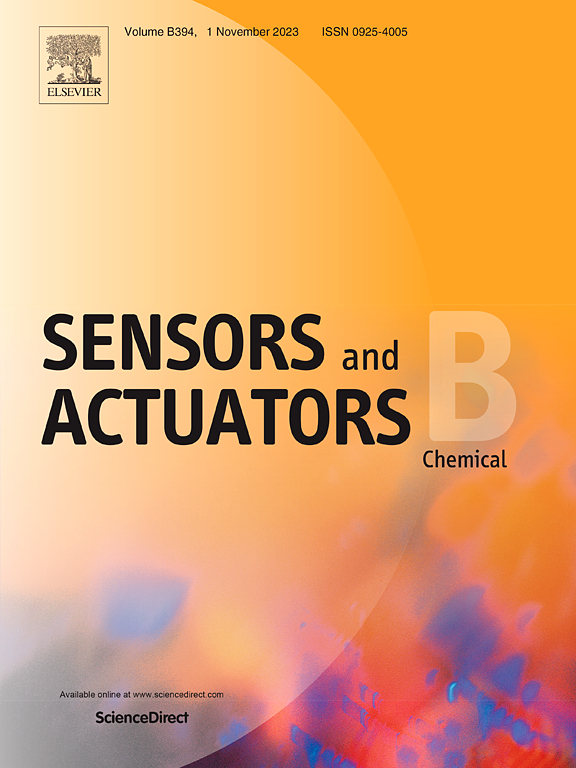An ultrasensitive electrochemical biosensor for ATP detection in human serum based on tetrahedral nanostructured peptides and exonuclease I-assisted signal amplification strategy
IF 8
1区 化学
Q1 CHEMISTRY, ANALYTICAL
引用次数: 0
Abstract
Adenosine triphosphate (ATP) is intricately associated to various pathophysiological processes, serving as a crucial energy source for cellular activities. However, the development of a sensitive ATP detection method applicable in complex media presents significant challenges owing to severe biofouling. Herein, a robust antifouling biosensor was developed by utilizing tetrahedral nanostructured peptides containing D-amino acids (D-TPEP) in conjunction with DNA strands for the detection of ATP. The synthesized MXene-doped poly(3,4-ethylenedioxythiophene) (PEDOT) nanocomposites effectively enhanced the conductivity of the electrode and provided an efficient platform for the immobilization of D-TPEP/DNA conjugate. Specifically, D-TPEP was engineered to connect complementary DNA (cDNA), while probe DNA (pDNA) was incorporated through the complementary base pairing, thereby facilitating the formation of double-stranded DNA (dsDNA). By targeting the ATP model, pDNA was induced to detach from the dsDNA through specific binding and subsequently entered the exonuclease I-mediated target recycling process, resulting in signal amplification. Furthermore, the integration of D-TPEP/DNA conjugate with PEDOT/MXene nanocomposite enhanced the anti-biofouling ability of the biosensor, thereby facilitating direct detection of serum samples without any pretreatment. The biosensor demonstrated a relatively broad linear range from 0.1 fM to 1 nM, with a detection limit (LOD) as low as 0.07 fM. Consequently, this study successfully accomplished the ultrasensitive detection of ATP in biological environments and established a strategy for the development of low-fouling biosensors applicable to clinical diagnostics.

基于四面体纳米结构肽和外切酶i辅助信号放大策略的超灵敏电化学生物传感器检测人血清ATP
三磷酸腺苷(ATP)是细胞活动的重要能量来源,与多种病理生理过程密切相关。然而,由于严重的生物污染,开发一种适用于复杂介质的灵敏ATP检测方法面临着重大挑战。本文利用含有d -氨基酸的四面体纳米结构肽(D-TPEP)与DNA链结合,开发了一种强大的防污生物传感器,用于检测ATP。合成的mxene掺杂聚(3,4-乙烯二氧噻吩)(PEDOT)纳米复合材料有效提高了电极的导电性,为D-TPEP/DNA缀合物的固定提供了有效的平台。具体来说,D-TPEP被设计成连接互补DNA (cDNA),而探针DNA (pDNA)通过互补碱基配对被结合,从而促进双链DNA (dsDNA)的形成。通过靶向ATP模型,诱导pDNA通过特异性结合与dsDNA分离,随后进入外切酶i介导的靶循环过程,导致信号放大。此外,将D-TPEP/DNA偶联物与PEDOT/MXene纳米复合材料整合,增强了生物传感器的抗生物污染能力,从而使血清样品的直接检测无需任何预处理。该传感器线性范围较宽,从0.1 fM到1 nM,检测限低至0.07 fM。因此,本研究成功实现了生物环境中ATP的超灵敏检测,为开发适用于临床诊断的低污染生物传感器奠定了战略基础。
本文章由计算机程序翻译,如有差异,请以英文原文为准。
求助全文
约1分钟内获得全文
求助全文
来源期刊

Sensors and Actuators B: Chemical
工程技术-电化学
CiteScore
14.60
自引率
11.90%
发文量
1776
审稿时长
3.2 months
期刊介绍:
Sensors & Actuators, B: Chemical is an international journal focused on the research and development of chemical transducers. It covers chemical sensors and biosensors, chemical actuators, and analytical microsystems. The journal is interdisciplinary, aiming to publish original works showcasing substantial advancements beyond the current state of the art in these fields, with practical applicability to solving meaningful analytical problems. Review articles are accepted by invitation from an Editor of the journal.
 求助内容:
求助内容: 应助结果提醒方式:
应助结果提醒方式:


